This is just a sample of the many
antique surveying instruments we have sold.
Click link to see other
Past Sales Archive Pages on this Site.
We Buy Quality Surveying Related Antiques
Contact Us at
AntiqBuyer@gmail.com
Special Note Concerning Prices Seen Below:
Most prices seen reflect actual sale results from this website.
Prices seen
span a long time and may not reflect current values. Some are selling
for more, many now sell for less.
On other pieces you will see no price, or a price range,
with or without an explanation. The reasons for that are discussed on the FAQ page.
Our current offering of Antiques for sale are at our sister Website Patented-Antiques.com.
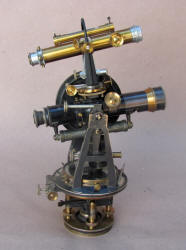 Fauth
&
Co. Solar Transit
w/ George Saegmuller Solar Attachment
This is a rare and unusual solar transit. It is an
expedition size instrument with its main scope just about 7" long. The transit is
double marked with both maker & company names. Under the glass is the name
Fauth & Co. This company was formed in the 1870's between George Saegmuller
and his two brothers in law, Camille Fauth and Henry Lockwood. On the
beveled plate, next to the vernier, it is marked George N. Saegmuller Wash.
DC. This is an unusual feature to be found on any transit, and was very
hard to manufacture and keep in working order.
Fauth
&
Co. Solar Transit
w/ George Saegmuller Solar Attachment
This is a rare and unusual solar transit. It is an
expedition size instrument with its main scope just about 7" long. The transit is
double marked with both maker & company names. Under the glass is the name
Fauth & Co. This company was formed in the 1870's between George Saegmuller
and his two brothers in law, Camille Fauth and Henry Lockwood. On the
beveled plate, next to the vernier, it is marked George N. Saegmuller Wash.
DC. This is an unusual feature to be found on any transit, and was very
hard to manufacture and keep in working order.In later years Saegmuller bought out both partners, first Mr. Lockwood, and
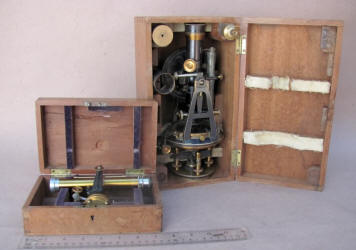 around the turn of the
century Fauth. Shortly afterward he renamed the company George N.
Saegmuller. I am not sure if this is a transition piece made right near the
turn of the century after he renamed the company, or an earlier instrument made
for Fauth and signed by Saegmuller when he worked as part of Fauth & Co.
around the turn of the
century Fauth. Shortly afterward he renamed the company George N.
Saegmuller. I am not sure if this is a transition piece made right near the
turn of the century after he renamed the company, or an earlier instrument made
for Fauth and signed by Saegmuller when he worked as part of Fauth & Co. George Saegmuller is most famous for his design and patent of the solar attachment you see. He was granted the patent for this idea in the 1870's. The one pictured came with this instrument, but is housed in its own box. The box has some damage to the lid, but looks OK. The optics of the solar attachment are crisp and clear. The eyepiece cap or right angle piece is missing as can be seen. The overall condition is like new.
The transit has an 7" scope and would be designated as a Expedition model. The box for the transit is a study in compactness, and there is no way you could have ever fit the solar attachment in the same box. Being an expedition size they tried to keep everything as small and compact as possible to be easier to transport in the field. The transit is factory fitted with a mount on the top of the scope to accept the solar attachment. Solar attachments gave the user a very exact way to determine their exact location using the sun and the horizon. They were especially useful here in the west or in places where large deposits of minerals or ore could affect the magnetic compass readings allowing for mistakes in the work being performed.
The mahogany box for the transit shows just a few minor scuffs from storage. All motions are free and turn as they should. The optics are perfect and exhibit no cloudiness or other problems. The crosshairs 1 vertical, 3 horizontal, and 2 crossed in the middle are present. The compass needle works, and measures 2 1/2" long . This is a very rare example of a desirable solar transit and one I have not seen offered for sale before. It is an opportunity that will not likely present itself again for a long time.
Excellent . . . . . . .$4750.00 SOLD!!
 Bausch
& Lomb Transit w/ Saegmuller Solar Attachment Bausch & Lomb
is most famous for their line of binoculars
and other optics but ventured in to the surveying instrument field after George N. Saegmuller joined the company in 1905.
They stopped making things for the general public during WWI so they were
not in the surveying instrument business for long. There is a nice history
on the company at the
SurveyHistory.org
site. This solar transit has the logo the company adopted after 1907 and dates
from right around that time period. Both the transit, and its Saegmuller
Attachment comes in their proper, well worn, original boxes.
Bausch
& Lomb Transit w/ Saegmuller Solar Attachment Bausch & Lomb
is most famous for their line of binoculars
and other optics but ventured in to the surveying instrument field after George N. Saegmuller joined the company in 1905.
They stopped making things for the general public during WWI so they were
not in the surveying instrument business for long. There is a nice history
on the company at the
SurveyHistory.org
site. This solar transit has the logo the company adopted after 1907 and dates
from right around that time period. Both the transit, and its Saegmuller
Attachment comes in their proper, well worn, original boxes. Solar transits were introduced or developed because of issues using magnetic compasses that could be thrown off by mineral deposits where they were being used. The basic idea is to allow the user to find his location using the horizon and sun, much as mariners use a sextant to find their location out on the open seas with no other reference points. This instrument has a Saegmuller design solar attachment that is marked Lietz, the well known California maker from the same general era. It comes in its proper, well worn original box.
The transit is in overall very nice condition with original patina. The compass works as it should. Note the design feature where the plate level bubbles are under the glass w/ the compass. All level bubbles are good. All motions are smooth. The transit optics and crosshairs are good. So are the multiple cross hairs in the attachment. An unusual and nice instrument along with a rare and desirable Saegmuller solar attachment. Both by seldom seen makers. It will make for a nice addition to any collection.
Fine . . . . . . $3295.00 SOLD!!
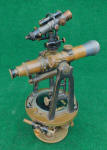 Bausch
& Lomb Solar Transit Solar
transits are a an unusual form of surveying transit.They were introduced or developed because of
issues using compasses that could be thrown off by mineral deposits
where they were being used. The basic
idea is to allow the user to find his location using the horizon and sun,
much as mariners use a sextant to find their location out on the open
seas with no other reference points.
Bausch
& Lomb Solar Transit Solar
transits are a an unusual form of surveying transit.They were introduced or developed because of
issues using compasses that could be thrown off by mineral deposits
where they were being used. The basic
idea is to allow the user to find his location using the horizon and sun,
much as mariners use a sextant to find their location out on the open
seas with no other reference points.Bausch & Lomb are most famous for their line of binoculars and other optics but ventured in to the surveying instrument field after George N. Saegmuller joined the company in 1905. This solar transit has the logo the company adopted after 1907 and dates from right around there. They stopped making things for the general public during WWI so they were not in the surveying instrument business for long. There is a nice history on the company at the SurveyHistory.org site.
The transit is in overall very nice condition. All level bubbles are good, and motions are smooth. The transit optics are good. A nice instrument by a maker seldom seen on the market.
Fine . . . . . . $2795.00
SOLD!!
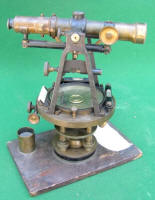
Burt solar attachments
were typically the style used by Gurley
and Roach on their instruments. Roach had patented the idea of
applying a solar attachment to transits and sold the rights to that idea to
Gurley. This transit is set up to
accept a solar attachment with the threaded attachment point on the top of
the scope. It probably looked like a Saegmuller as Burt solar attachments,
which resembles a miniature sextant, usually set down over a post. I
suppose Sala offered either design as options as I have seen Sala
instruments with a Burt solar.
Solar transits were developed so that the user could
accurately determine his location without relying on the compass in the
field. Magnetic deviations, especially here in the west, and in
other locations where the geography contains large amounts of magnetic ore could throw off a compass and were not an accurate means to determine ones
location in certain areas. The idea was to use the position of the sun, and the horizon,
to determine ones location. Much as a sextant or octant would
be used to determine ones true location on a boat in open water with no
visible reference points. There are a number
of different versions of solar attachments that were patented and used on
surveying instruments. The Burt solar attachment was used on Gurley
instruments and on those by Sala and Roach. K & E used the Saegmuller
style which was a small telescope that mounts above the main scope. Other
types of solar attachments are the Smith and Pearson Patent Solar Attachments
named after the patent holder or inventor.
The transits main
scope is 11" long which would make this an engineers or surveyors transit .
It has an erect image and the optics are crisp and clear. The silvered
compass face is nice, and the needle operates properly. All other motions
seem to operate as they should. The box is nice. The instrument itself has
developed a nice even patina.
This transit will display very nicely and be a
highlight of any collection of surveying related instruments or California
history.
Good + . . . . . . $895.00 SOLD!!
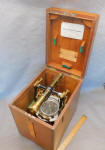 William
Young ALUMINUM Transit An
unusual and nice example of William Young's work. Young is credited
with producing the first surveying instruments known as transits in the 1830s.
The serial # of this transit is in the 8000s thus dating it from shortly
after the turn of the century and before Young sold out to K & E in 1918
or so.
William
Young ALUMINUM Transit An
unusual and nice example of William Young's work. Young is credited
with producing the first surveying instruments known as transits in the 1830s.
The serial # of this transit is in the 8000s thus dating it from shortly
after the turn of the century and before Young sold out to K & E in 1918
or so.The use of Aluminum in surveying instruments, because of the light weight and being non-magnetic is quite unusual on instruments this early. Aluminum was still a relatively new material to work with and had drawbacks in use. It was soft, and at this point in time was pretty brittle and prone to cracking. As can be seen some parts are in brass as well, and the contrasting materials, and finishes, give it a very pleasing look.
The transit has been cleaned and adjusted. The motions are OK noting some stiffness in the main plate. Good optics w/ crosshairs. It comes in the original box. The fixed leg wooden tripod, with an Aluminum head, is included as well.
Fine . . . . . $1200.00 SOLD!!
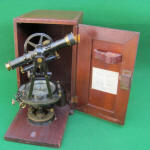 H.
S. Crocker San Francisco / Sacramento
Surveyor's Transit This unusual
surveying transit is in excellent condition.It is marked H. S. Crocker Co. San
Francisco / Sacramento under the glass on the silvered compass face.
While there is plenty of info on the H. S. Crocker company and their history in California
during and after the Gold Rush Era, I can find no information or reference to them
making surveying instruments, or mention of other instruments marked with
their name. There are no other
examples or references to others be found at the several surveying
instrument reference sites
online, and there is no reference in Smarts reference book on instruments either. One
possibility is that Crocker is not the maker, and that it was made for them
by somebody else. I am not sure who that would be as it has
characteristics unlike most of the better known makers of the time. I
am pretty sure it is not a Gurley or K & E, and have been told it is perhaps
a Queen or Young out of Pennsylvania. The most notable feature is the way the caps are done to hold the scope in place with
split screws. (see Pic 5226)
H.
S. Crocker San Francisco / Sacramento
Surveyor's Transit This unusual
surveying transit is in excellent condition.It is marked H. S. Crocker Co. San
Francisco / Sacramento under the glass on the silvered compass face.
While there is plenty of info on the H. S. Crocker company and their history in California
during and after the Gold Rush Era, I can find no information or reference to them
making surveying instruments, or mention of other instruments marked with
their name. There are no other
examples or references to others be found at the several surveying
instrument reference sites
online, and there is no reference in Smarts reference book on instruments either. One
possibility is that Crocker is not the maker, and that it was made for them
by somebody else. I am not sure who that would be as it has
characteristics unlike most of the better known makers of the time. I
am pretty sure it is not a Gurley or K & E, and have been told it is perhaps
a Queen or Young out of Pennsylvania. The most notable feature is the way the caps are done to hold the scope in place with
split screws. (see Pic 5226) The scope on this unusual instrument is 9" long making it a light mountain size. The optics are crisp and clear. All of the level vials are full and appear to be original.All motions are smooth. The box shows signs of having been covered with fabric or canvas at one time given all the small holes in the wood.
A rare instrument in very nice condition and will be a highlight of any display or collection.
Fine . . . . . . $1750.00 SOLD!!
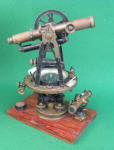 Warren
Knight "Sterling" Solar Transit w/ Saegmuller Solar Attachment
This Warren Knight Solar transit is a very nice instrument that has a great look
when all set up. This transit is set up to accept the Saegmuller solar attachment
seen in the first pic mounted on the board next to the instrument. K & E
used a dovetail sliding arrangement to mount their Saegmuller solar on their instruments.
Warren Knights version used a threaded mount.
The
transits main
Warren
Knight "Sterling" Solar Transit w/ Saegmuller Solar Attachment
This Warren Knight Solar transit is a very nice instrument that has a great look
when all set up. This transit is set up to accept the Saegmuller solar attachment
seen in the first pic mounted on the board next to the instrument. K & E
used a dovetail sliding arrangement to mount their Saegmuller solar on their instruments.
Warren Knights version used a threaded mount.
The
transits main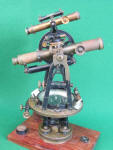 scope is 11" long which would make this an engineers or surveyors transit .
It has an erect image and the optics are OK. The compass face is nice, and
the needle operates properly. All other motions seem to operate as they
should. The box is nice. The instrument itself has developed a nice even
patina on the brass surfaces, and those areas that were finished in black
are showing their age.
scope is 11" long which would make this an engineers or surveyors transit .
It has an erect image and the optics are OK. The compass face is nice, and
the needle operates properly. All other motions seem to operate as they
should. The box is nice. The instrument itself has developed a nice even
patina on the brass surfaces, and those areas that were finished in black
are showing their age.Solar transits were developed so that the user could accurately determine ones location without relying on the compass in the field. Magnetic deviations, especially here in the west, and in other locations where the geography contains large amounts of magnetic ore could throw off a compass and were not an accurate means to determine ones location in certain areas. The idea was to use the position of the sun, and the horizon, to determine ones location. Much as a sextant or octant would be used to determine ones true location on a boat in open water with no visible reference points.
There are a number of different versions of solar attachments that were patented and used on surveying instruments. The Burt solar attachment, which looks like a miniature sextant, was used on Gurley instruments and on those by California makers Sala and Roach. K & E used the Saegmuller style, as seen here, which was a small telescope that mounts above the main scope. Other types od solar attachments are the Smith and Pearson Patent Solar Attachments named after the patent holder or inventor.
This solar transit will display very nicely and be a highlight of any collection of surveying related instruments.
Good + . . . . . . $2250.00 SOLD!!
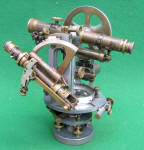 Young
& Sons Solar Transit with Smith Patent Telescopic Solar Attachment in Original Box This
is a rare c. 1913 Young solar transit with an unusual Smith Patent
Telescopic Solar attachment.This transit is
called off as No. 10 in an early Young catalogs. The
patent for the solar attachment was first granted in 1880. This
example is an improved model that was patented in 1902. The serial number on
the transit indicates it dates from shortly after the turn of the century.
Young
& Sons Solar Transit with Smith Patent Telescopic Solar Attachment in Original Box This
is a rare c. 1913 Young solar transit with an unusual Smith Patent
Telescopic Solar attachment.This transit is
called off as No. 10 in an early Young catalogs. The
patent for the solar attachment was first granted in 1880. This
example is an improved model that was patented in 1902. The serial number on
the transit indicates it dates from shortly after the turn of the century. Young's use of Aluminum for many of the different parts of the transit is very unusual for an instrument from this time period. It has a 4˝" horizontal circle, a 4" silvered vertical circle, a 3.3" needle, and a 10" main telescope. The telescope on the Smith solar unit is 7" long, and is inscribed "Pat Sep 16, 1902." There is a counterweight that mounts on the standard opposite the side with the solar unit. All motions are free and move smoothly. The compass works as it should. Note that there is a vernier scale on the outside plate, and another under the glass.
Fine . . . . . . $3750.00 SOLD!!
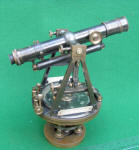 Heller
& Brightly
Engineers Transit The overall condition
of this large graphic surveyor's / engineers transit is very nice. The main scope on this surveyors
or engineers transit is 11" long. The
bronzed lacquer finish is in great condition and has developed a nice even
patina. The serial numbers on the instrument and box match. 2 level
vials are good and one is empty. All motions are free and the compass works.
Note how the leveling head detaches and mounts separate in the box.
Heller
& Brightly
Engineers Transit The overall condition
of this large graphic surveyor's / engineers transit is very nice. The main scope on this surveyors
or engineers transit is 11" long. The
bronzed lacquer finish is in great condition and has developed a nice even
patina. The serial numbers on the instrument and box match. 2 level
vials are good and one is empty. All motions are free and the compass works.
Note how the leveling head detaches and mounts separate in the box. The serial # is 5228 which from published records we can assume dates this large transit w/ compass from the early 1880's or so. Heller and Brightly formed their partnership in 1870. Heller had worked for Young previously, and before Young died in 1870 he had become a partner in that firm. This was before teaming up with Brightly soon after Young's death and starting the new firm of Heller & Brightly. H & B began their numbering system at 4400 and so this would be approx. the 800th instrument made after they began operations.
All in all a pretty rare instrument that will not turn up often and will make for a great display in the mining collection, or the surveying instrument collection.
Good . . . . . . $1095.00 SOLD!!
Info on Heller & Brightly from the Smithsonian Site
Heller & Brightly Charles S. Heller (1839–1912) was born in Germany, and moved with his family to the United States in the late 1840s. He went to work for William J. Young in 1855, and became a partner in William J. Young & Co. in 1865. Charles H. Brightly (1817–1897) was born in England, arrived in the United States in the 1830s, and worked as a machinist in Philadelphia before going into partnership with Heller in 1870. Within a few years Heller & Brightly were said to have "done more than any other [firm] in this country of late years to increase competition in the trade, and to wake up the different makers to a sense of the many improvements that may be made in the instruments in common use." Heller & Brightly instruments were used in every state in the union, and in several foreign countries. The firm was incorporated in 1926, and remained in business until 1968.
Heller & Brightly was a traditional craft workshop. There were only a few employees at any one time, each could produce an entire instrument, and each was reasonably well paid. They produced some 100 instruments per year from 1870 to 1887. Annual production rose to 216 instruments in 1891, then dropped precipitously and remained at modest levels thereafter. Each instrument has a serial number, the first being #4400. Most Heller & Brightly instruments were ordered directly from the shop, with only a few sold in stores. Ref: Robert C. Miller, "The Heller & Brightly Records," Rittenhouse 4 (1990): 43–55.
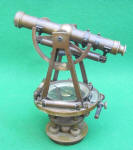 John
Roach Surveying Transit John Roach's
working dates were from approx. 1833 to 1891 when he died. He was
California's second well known surveying instrument maker. William
Albert Schmolz was California's first recognized surveying instrument maker. John Roach came
to California during the beginning of the Gold Rush era. The serial # on
this transit is 791 and using some creative math and a bit of guesswork would date this
transit from a period near the Civil War.
John
Roach Surveying Transit John Roach's
working dates were from approx. 1833 to 1891 when he died. He was
California's second well known surveying instrument maker. William
Albert Schmolz was California's first recognized surveying instrument maker. John Roach came
to California during the beginning of the Gold Rush era. The serial # on
this transit is 791 and using some creative math and a bit of guesswork would date this
transit from a period near the Civil War.Before coming to California Roach had been in partnership in New York with a fellow named Warner. Another instrument maker named J. C. Sala worked with John Roach here in California and later took over the business after Roaches death in 1891. Roach instruments are not common and are a well made example of precision quality.
The transits scope is 11" long which would make this an engineers or surveyors transit . It has an erect image and the optics are clear w/ crosshairs. The blackened compass face is nice, and the needle operates properly. It has a nice overall appearance and patina. All motions seem to operate as they should noting that the thumbscrew which would lock the scope is broken off. The box is OK. There is no tripod.
This transit will display very nicely and be a highlight of any collection of surveying related instruments or California history.
Good + . . . . . .$950.00 SOLD!
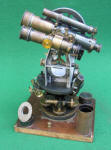 P & R Wittstock / Berlin "Scott's" Mine Tachymeter / Mining Transit
The overall condition of this unusual surveying instrument is very nice. This style transit / theodolite is
pictured online in the book titled "The evolution of mine-surveying instruments" by Dunbar Scott. That online book,
published in the 1890's, illustrates, discusses and makes claims for this style instrument as being very useful and an
advanced design. The serial # on this piece is 604. Other than the reference noted above there is little info to be
found on this maker or instrument online. Wittstock is not listed in Smarts, and there are no examples in the Smithsonian collection.
P & R Wittstock / Berlin "Scott's" Mine Tachymeter / Mining Transit
The overall condition of this unusual surveying instrument is very nice. This style transit / theodolite is
pictured online in the book titled "The evolution of mine-surveying instruments" by Dunbar Scott. That online book,
published in the 1890's, illustrates, discusses and makes claims for this style instrument as being very useful and an
advanced design. The serial # on this piece is 604. Other than the reference noted above there is little info to be
found on this maker or instrument online. Wittstock is not listed in Smarts, and there are no examples in the Smithsonian collection. The leather cover for the box is coming apart at the seams and is very fragile. It did a good job protecting the wooden box which is in fine condition. (see pics) The instrument itself, and the auxiliary scope are very nice. The main scope is approx. 8" and the smaller one 6". Both have sun shades and reflectors. There are also lens covers for both. The counterweight which mounts opposite the aux. scope screws onto the wooden base when not in use. There is a spot built inside the box for the second scope but no means to lock it in place. The optics are good, and crosshairs are present in both scopes. There are also 2 right angle eyepieces with a sliding feature for 3 different lenses. Note the 2 magnifiers to aid in reading both the vertical and plate vernier scales. All motions operate smoothly. The leveling head and plate are made of brass. The instrument frame is cast aluminum. The scopes are constructed of both brass and aluminum making for interesting contrasts. The maker info and serial # are stamped onto the top plate. The collapsible leg tripod in the last pic is included. It is a small light weight piece in nice condition. The cap for it is a C.L. Berger but it fits the instrument properly and i believe is original to it. Nice!!
This transit looks great and will display very nicely in, and be a highlight of, any collection of surveying related instruments or mining related collection.
Fine . . . . . . $1950.00 SOLD!!
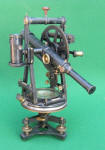 Cary
/ London Mining Theodolite / Transit w/ Aux. Oil Wick Light
This unusual English Mining Transit / Theodolite is in superb original condition.
It dates from near the turn of the century. Be sure to look at all the pics
to see the details and how it is fitted into the original Mahogany
Cary
/ London Mining Theodolite / Transit w/ Aux. Oil Wick Light
This unusual English Mining Transit / Theodolite is in superb original condition.
It dates from near the turn of the century. Be sure to look at all the pics
to see the details and how it is fitted into the original Mahogany
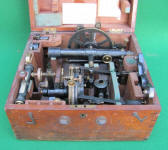 box.
It is complete and then some. Some features are as follows. There are 3 different
interchangeable rear eyepieces.
A short one, a long one, and a right angle one. There is also an extra
set of crosshairs in a small brass container in the box.
box.
It is complete and then some. Some features are as follows. There are 3 different
interchangeable rear eyepieces.
A short one, a long one, and a right angle one. There is also an extra
set of crosshairs in a small brass container in the box. The most unusual feature of this mining transit / theodolite is the small oil fired aux light for use in mines or poor lighting conditions that is still present and complete in the box. (See pic of different parts) It is mounted on the left side of the theodolite in the left side pic above. This small auxiliary light can be mounted on either side of the transit. The main scopes axis is hollow and has a lens on both sides that this light would shine light into illuminating the inside of the scope so the user could see better for use in mines or other poor lighting conditions. Note also that this instrument has four small magnifiers to aid in reading the scales. 2 on the lower plate and 2 for the vertical circle vernier. The plate vernier is silver and beveled. The compass operates and points north. The compass face is silvered and very nice. This instrument also has a removable striding level which fits crosswise on top after the instrument has been set up. A wonderful and very graphic looking instrument.
Fine. . . . .$2950.00 SOLD!!
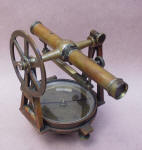 Knox
& Shain Surveyors / Engineers Transit The partnership of Knox
and Shain was begun in the 1850's. The Smithsonian sight says they opened
their shop in 1850, while the bio on them in Smarts says they were first listed
together in the Philadelphia directories in 1855. The serial # on the compass
face is 900. It is not known if this number reflects the date from the beginning
of this partnership, or from the time Knox left the employ of Young and opened his
own shop some years earlier. This transit though has the look and fell of
an instrument that dates from the 1860's to 1880's. The Smithsonian
site mentions that Knox & Shain instruments look similar to Young's transits because
both partners worked for him in the past. The information there goes on to
say they bought the dividing engine of Jesse Ramsden, an early English maker of
surveying and other scientific instruments. .
Knox
& Shain Surveyors / Engineers Transit The partnership of Knox
and Shain was begun in the 1850's. The Smithsonian sight says they opened
their shop in 1850, while the bio on them in Smarts says they were first listed
together in the Philadelphia directories in 1855. The serial # on the compass
face is 900. It is not known if this number reflects the date from the beginning
of this partnership, or from the time Knox left the employ of Young and opened his
own shop some years earlier. This transit though has the look and fell of
an instrument that dates from the 1860's to 1880's. The Smithsonian
site mentions that Knox & Shain instruments look similar to Young's transits because
both partners worked for him in the past. The information there goes on to
say they bought the dividing engine of Jesse Ramsden, an early English maker of
surveying and other scientific instruments. . This surveyor's transit is in good condition. It stands just about 11" tall to the top of the 5" vertical circle which reads to 30 degrees. This transit is from an era when the leveling base remained with the tripod, which we do not have. There is no place for it in the box. which is OK. The box is dirty and has been re-glued where it split at some point in the past but has a great look and a lot of character.
The compass is a gold finish and works properly. The needle is 5" and the transit measures approx 7" across. The silvered horizontal vernier is inside under the glass and operates as it should. All other knobs and motions are free as well. All three level bubbles are full and appear to be original. The optics are clear, and it focuses well, but there do not seem to be any cross hairs if there ever were any.
This Knox & Shain is a very early transit, by a relatively rare and obscure maker from Philadelphia one of the hubs of early technology manufacturing in America. This transit will make for a great showpiece on display in the collection or any other setting.
Good+ . . . . . . .$650.00 SOLD!
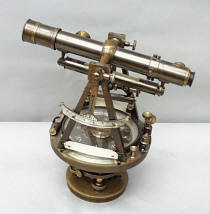 Heller
& Brightly Transit The serial #
on this super condition Surveyor's transit is 4683, and from the information
available from the Smithsonian's informative site on surveying instruments we
can surmise that this instrument was made in the early 1870's just a few short
years after this company was formed between Charles Heller and Charles Brightly.
The serial # can be found in three separate places, on the inside of the box,
on the lower detachable leveling base, and under the glass of the highly engraved
compass face. From the information found at the Smithsonian's site we
can see that this company started their serial #'s at 4400 which would put this
instrument at the very beginnings of this companies time line.
( see below for the info from that site, and a link to it for further info )
Heller
& Brightly Transit The serial #
on this super condition Surveyor's transit is 4683, and from the information
available from the Smithsonian's informative site on surveying instruments we
can surmise that this instrument was made in the early 1870's just a few short
years after this company was formed between Charles Heller and Charles Brightly.
The serial # can be found in three separate places, on the inside of the box,
on the lower detachable leveling base, and under the glass of the highly engraved
compass face. From the information found at the Smithsonian's site we
can see that this company started their serial #'s at 4400 which would put this
instrument at the very beginnings of this companies time line.
( see below for the info from that site, and a link to it for further info )
The original condition of this instrument is second to none, and it is obvious that it has seen little or no use over the last 130 years. The unusual Mahogany box is nice, noting that the leather handle has come unattached. This transit also includes a correctly marked and original tripod, and the correctly marked original plumb bob and an instruction sheet on setting the instrument up are also included. ( These are Not Pictured ) The original lacquer finish is near perfect and all motions are free and smooth. The level vials are all good.
These early transits were hand built and Heller and Brightly was a small company that produced less than 100 instruments a year in their early days. Note the unique feature of the leveling base being detachable and fitting into a separate holding position inside the box. All in all one of the nicest and earliest American transits that I have had the pleasure of buying. The condition is second to none, and it will be a long time before another in this condition or this early ever shows up again on the market.
Good . . . . .$1250.00 SOLD
Info from the Smithsonian Site
Heller & Brightly Charles S. Heller (1839–1912) was born in Germany, and moved with his family to the United States in the late 1840s. He went to work for William J. Young in 1855, and became a partner in William J. Young & Co. in 1865. Charles H. Brightly (1817–1897) was born in England, arrived in the United States in the 1830s, and worked as a machinist in Philadelphia before going into partnership with Heller in 1870. Within a few years Heller & Brightly were said to have "done more than any other [firm] in this country of late years to increase competition in the trade, and to wake up the different makers to a sense of the many improvements that may be made in the instruments in common use." Heller & Brightly instruments were used in every state in the union, and in several foreign countries. The firm was incorporated in 1926, and remained in business until 1968.Heller & Brightly was a traditional craft workshop. There were only a few employees at any one time, each could produce an entire instrument, and each was reasonably well paid. They produced some 100 instruments per year from 1870 to 1887. Annual production rose to 216 instruments in 1891, then dropped precipitously and remained at modest levels thereafter. Each instrument has a serial number, the first being #4400. Most Heller & Brightly instruments were ordered directly from the shop, with only a few sold in stores.
Ref: Robert C. Miller, "The Heller & Brightly Records," Rittenhouse 4 (1990): 43–55.
LLink: http://americanhistory2.si.edu/surveying/maker.cfm?makerid=16
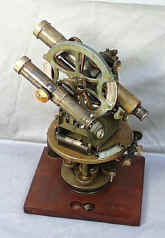
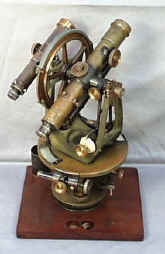 Dietzgen
Transit w/ Aux. Mining Scope Attachment & Scope w/ Setup for
Solar Attachment This transit dates from just
after the turn of the last century. I have an auxiliary sighting scope
that fits onto the outboard attachment point, but
I am also in the market for the small solar attachment that the top of this
transit is set up to accept. I believe it is a similar looking telescope
affair that is mounted in a U shaped yoke with a center threaded rod that would
go into the fitting visible on the top. It is a female receptacle, and
a different size from the base of the other scope that is present now.
Dietzgen
Transit w/ Aux. Mining Scope Attachment & Scope w/ Setup for
Solar Attachment This transit dates from just
after the turn of the last century. I have an auxiliary sighting scope
that fits onto the outboard attachment point, but
I am also in the market for the small solar attachment that the top of this
transit is set up to accept. I believe it is a similar looking telescope
affair that is mounted in a U shaped yoke with a center threaded rod that would
go into the fitting visible on the top. It is a female receptacle, and
a different size from the base of the other scope that is present now.
Good . . . . .$1250.00 SOLD
 A.
Lietz Co. Light Mountain Transit I believe
that this beautiful little instrument would be considered a Light Mountain Size
Transit, both because of the overall size, and the bayonet or twist lock system
for locking it to the tripod. But it may be their Expedition size
as it is so small, and I have no catalogs to check on this. The
tube measures 7.5 inches long, and the overall height is just about 10" to the
top of the wheel. The optics are clear and crisp as are the 3 crosshairs.
The compass measures just 3" across and works properly. The limb measures
4.5 inches across at this point. The serial # 6220 is written on the compass
face which is black and in perfect condition. The level vials are good
and appear to be original. All of the other knobs and wheels appear to
be working as well. This piece has never been polished and
has a nice even patina. Those portions that were finished in black look
good as well, noting some minor losses to the edges of the wheel. At some
point, a well meaning antique dealer did refinish the box. There are a
series of original labels inside the lid of the box. The mounting
system for the instrument to the tripod is a simple line it up and twist with
no threads to be found. I have given you a series of pics, but if
you need more or have questions simply ask.
A.
Lietz Co. Light Mountain Transit I believe
that this beautiful little instrument would be considered a Light Mountain Size
Transit, both because of the overall size, and the bayonet or twist lock system
for locking it to the tripod. But it may be their Expedition size
as it is so small, and I have no catalogs to check on this. The
tube measures 7.5 inches long, and the overall height is just about 10" to the
top of the wheel. The optics are clear and crisp as are the 3 crosshairs.
The compass measures just 3" across and works properly. The limb measures
4.5 inches across at this point. The serial # 6220 is written on the compass
face which is black and in perfect condition. The level vials are good
and appear to be original. All of the other knobs and wheels appear to
be working as well. This piece has never been polished and
has a nice even patina. Those portions that were finished in black look
good as well, noting some minor losses to the edges of the wheel. At some
point, a well meaning antique dealer did refinish the box. There are a
series of original labels inside the lid of the box. The mounting
system for the instrument to the tripod is a simple line it up and twist with
no threads to be found. I have given you a series of pics, but if
you need more or have questions simply ask.
Good . . . . .$750.00 SOLD
Bausch & Lomb Light Mountain Transit Bausch and Lomb had been in business for many years and were well known in the optics business before they went into a business partnership with, first, George Saegmuller in 1905, and then Carl Zeiss in 1907 at which point they also began to produce Surveying instruments, transits and other engineering instruments. They only manufactured surveying instruments up until the entry of the United States into the First World War in about 1917 when production stopped. After the war, production of these sorts lines was never resumed. It seems there was better money making things for the military and that became their primary focus.
Everything on this small transit seems to be working nicely, and the optics are clear. It has developed a nice rich even patina. I believe this transit was made in 1908 from the chart that gives that information that I was able to find on the internet. Given the short production span, and the limited number produced, instruments by these folks are pretty hard to come by. This includes the proper and original collapsible tripod as well.
Top Notch!!
Good . . . . .$950.00 SOLD
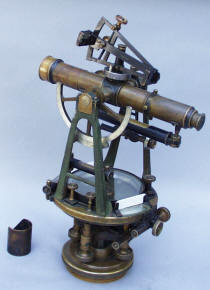 Sala
Transit w/ Burt Style Solar Attachment This
transit was made by one of the three famous West Coast Surveying Instrument
Makers out of San Francisco During the 19th century. These makers were
William Albert Schmolz, John Roach, and Joseph Charles Sala. Schmolz,
whose working dates were from the mid 1850's until his death in 1891 was the
person first responsible for patenting the idea to adapt the Burt Solar Apparatus
to a transit and was granted a patent for this idea in 1867. Gurley bought
the rights to this idea, and introduced their version around 1874, agreeing
to pay Schmolz $5.00 for each one they sold. This agreement expired in
1884 when the patent became part of the public domain. This instrument
dates from some point after that, as Sala who was born in 1841 and at first
apprenticed to Roach was listed first in San Francisco Directories as Roach's
partner in the 1861 Directory took over the business upon Roach's death in 1891.
This instrument is #934 and was probably made just after the turn of the century.
Sala died in 1916.
Sala
Transit w/ Burt Style Solar Attachment This
transit was made by one of the three famous West Coast Surveying Instrument
Makers out of San Francisco During the 19th century. These makers were
William Albert Schmolz, John Roach, and Joseph Charles Sala. Schmolz,
whose working dates were from the mid 1850's until his death in 1891 was the
person first responsible for patenting the idea to adapt the Burt Solar Apparatus
to a transit and was granted a patent for this idea in 1867. Gurley bought
the rights to this idea, and introduced their version around 1874, agreeing
to pay Schmolz $5.00 for each one they sold. This agreement expired in
1884 when the patent became part of the public domain. This instrument
dates from some point after that, as Sala who was born in 1841 and at first
apprenticed to Roach was listed first in San Francisco Directories as Roach's
partner in the 1861 Directory took over the business upon Roach's death in 1891.
This instrument is #934 and was probably made just after the turn of the century.
Sala died in 1916. This instrument is in an amazing state of preservation. The box is dovetailed, and has a later Lietz sticker in the top of the lid The compass face has a green finish and the points are nicely engraved. There is a half vertical circle, and the vernier is silvered. The solar attachment is clearly marked Sala, and is basically identical with the version put out by Gurley.
Good . . . . .$4000.00 SOLD
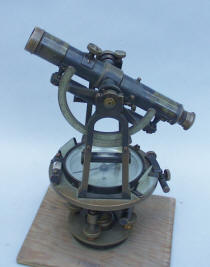 John
Zeiser St Louis Transit This transit was made by the little
known and rare maker of surveying instruments who hailed from St Louis just
after the turn of the 20th century. He is not listed in Smarts or at the
Smithsonian site, but there is a brief mention of his name as a maker on one
site on the internet. This example is a nicely done Light Mountain size
with a 9 1/2 inch scope and half circle vernier. The optics are clear
and it has a simple cross for the crosshairs. All motions turn freely
and the vials are full. The compass is functional as well. It has
developed a very nice patina and will display nicely. The serial # is
550. The box seems correct, but the plate it rests on is plywood and may be
a replacement. All in all a nice looking instrument by an obscure and
relatively rare maker.
John
Zeiser St Louis Transit This transit was made by the little
known and rare maker of surveying instruments who hailed from St Louis just
after the turn of the 20th century. He is not listed in Smarts or at the
Smithsonian site, but there is a brief mention of his name as a maker on one
site on the internet. This example is a nicely done Light Mountain size
with a 9 1/2 inch scope and half circle vernier. The optics are clear
and it has a simple cross for the crosshairs. All motions turn freely
and the vials are full. The compass is functional as well. It has
developed a very nice patina and will display nicely. The serial # is
550. The box seems correct, but the plate it rests on is plywood and may be
a replacement. All in all a nice looking instrument by an obscure and
relatively rare maker.
Good . . . . .$750.00 SOLD
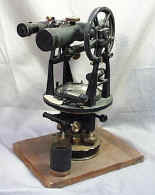 Heller
& Brightly Transit w/ Aux. Mining Scope Attachment
Transits set up to take an Auxiliary Scopes for either mining
related work or other precise applications are a unusual configuration. This
style of surveying instrument that was basically used in only one or two specific
applications. They were not widely distributed and thus quite hard to
find. With this example, the transit was made by Heller and Brightly of
Phila. PA., and the scope is unmarked, but I have been told is a Lietz who were
an established West Coast supplier, distributor, and manufacturer of quality
optical equipment and surveying supplies. It is a nice looking instrument.
Heller
& Brightly Transit w/ Aux. Mining Scope Attachment
Transits set up to take an Auxiliary Scopes for either mining
related work or other precise applications are a unusual configuration. This
style of surveying instrument that was basically used in only one or two specific
applications. They were not widely distributed and thus quite hard to
find. With this example, the transit was made by Heller and Brightly of
Phila. PA., and the scope is unmarked, but I have been told is a Lietz who were
an established West Coast supplier, distributor, and manufacturer of quality
optical equipment and surveying supplies. It is a nice looking instrument.
Good . . . . .$1450.00 SOLD
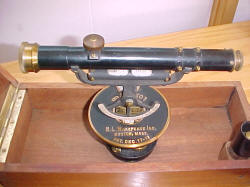 BB.
L. Makepeace Loxo Combination Transit / Level This small combination
Transit / Level was patented in 1912 and offered for sale after that. The Makepeace
company is still in business and has an long and interesting history that began
in the 1890's. The company began in the blueprint and paper end of the business, expanded
to offer a line of K & E products, and then just after the turn of the century
Mr. Makepeace began offering his own line and design of surveying instruments
including this style instrument.
BB.
L. Makepeace Loxo Combination Transit / Level This small combination
Transit / Level was patented in 1912 and offered for sale after that. The Makepeace
company is still in business and has an long and interesting history that began
in the 1890's. The company began in the blueprint and paper end of the business, expanded
to offer a line of K & E products, and then just after the turn of the century
Mr. Makepeace began offering his own line and design of surveying instruments
including this style instrument.
This combination level transit has seen little use and is in excellent condition. The box is very nice, and the label inside the lid is very good as well. The optics are clear, and the crosshairs present. The level vial is full and all motions turn freely. The bronzed lacquer finish is near flawless. There is no tripod. This instrument will make a nice addition to the collection to round out all the types and styles of instruments that were made and offered or would make for a good user around the property or building site. It will display very nicely.
Good . . . . .$350.00 SOLD
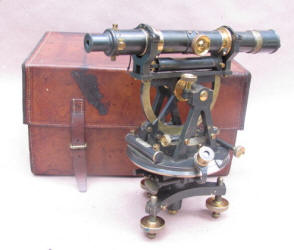 Negretti & Zambra Transit /
Theodolite
Negretti & Zambra was an English outfit whose origins dates back
into the mid 19th century. This transit / theodolite has an interesting form
with its half circle beneath the scope.
Negretti & Zambra Transit /
Theodolite
Negretti & Zambra was an English outfit whose origins dates back
into the mid 19th century. This transit / theodolite has an interesting form
with its half circle beneath the scope.
The leather covered mahogany box looks really nice. The box still has nearly all of its original finish. This instrument was dropped or handled badly at one point, as I had to re-glue nearly all of the different pieces inside, and repair a crack in the top where the base was trying to break through as it was banged around. It looks great now. The theodolite breaks down, and the different parts are fitted throughout the box as can be seen in the last photos. There is a bit of damage to two pieces from when it was shipped. The small aux magnifier lens, for the vernier, is cracked. Also a piece of the spring loaded fine adjust beneath the plate broke off at its attachment point when this was banging around in the box. The rest is fine, looks great and will display well..
The crosshairs are present, and the image is inverted. There is a stamp on the side of the scope indicating that this was made for a firm in Lima Peru. The serial number is in the 2000 range, but I could find no info that would allow for dating it. It has a 3 point leveling system, and it has the tripod mounting plate which is set up to fit in the box and has a quick release feature. an interesting design that will look fine as part of the display.
Good+ . . . . . .$650.00 SOLD!
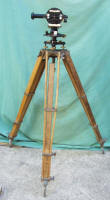 Hildebrand Freiberg Surveyors / Engineers Theodolite / Transit This precision Theodolite is by
Hildebrand Freiberg a well know and respected optical instrument maker that was begun in the 18th
century in Germany as Freiberg and evolved and changed names over a period of time to what it is now.
You can visit their present website here.
Hildebrand Freiberg Surveyors / Engineers Theodolite / Transit This precision Theodolite is by
Hildebrand Freiberg a well know and respected optical instrument maker that was begun in the 18th
century in Germany as Freiberg and evolved and changed names over a period of time to what it is now.
You can visit their present website here.The name Hildebrand became associated with the company in 1872 and Hildebrand Freiberg company was in operation until the Russians took control of the plant at the end of WWII. The only place this precision instrument is marked
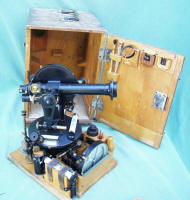 with the company name is on the handle of the case. There is also a stylized logo &
number on the instrument itself which probably would help date it for those with access to that info.
with the company name is on the handle of the case. There is also a stylized logo &
number on the instrument itself which probably would help date it for those with access to that info. This instrument dates from somewhere near the turn of the century up to the time of WWII when the Russians took over the plant. It is interesting to note the Japanese writing on the outside of the case and the "military" colored tan finish of the tripod would lead one to believe it was sold to and used by the Japanese military prior to or during WWII. The instrument itself is in great condition and is as complete as one could imagine or hope for. All of the level bubbles are good. All of the fitted holes in the internal carry case / tray are full and this instrument was designed to be locked into the case on the base to withstand all sorts of travel bumps and abuse. All of the tiny magnifiers over the vernier scales are present.
There is a striding level, an auxiliary compass, plumb bob, counterweight, and even a small wind up tape in feet / metric with Japanese writing. The tripod is nice, proper, and the instrument has the proper 3 point leveling base for it. There are also additional parts and pieces stored on the door, like an extra eyepiece, sunshade, and right angle eyepiece. The optics are clear and the cross hairs present. It is a very nice looking and graphic instrument to add to several different focus collections.
Good+ . . . . . .$750.00 SOLD!
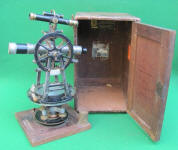 A.
Lietz Aluminum Solar Transit w/ Saegmuller Solar Attachment
This A. Lietz Solar transit is a very nice instrument
that has a great look when all set up. The entire instrument is made of
Aluminum except for the lower clamp brackets and leveling head parts which are
brass. This transit is set up to accept the Saegmuller solar attachment seen
mounted on the instrument in the first pic. K & E used a dovetail sliding
arrangement to mount their Saegmuller solar on their instruments. This
marked Lietz version used a threaded mount and is proper and right for the
instrument.
A.
Lietz Aluminum Solar Transit w/ Saegmuller Solar Attachment
This A. Lietz Solar transit is a very nice instrument
that has a great look when all set up. The entire instrument is made of
Aluminum except for the lower clamp brackets and leveling head parts which are
brass. This transit is set up to accept the Saegmuller solar attachment seen
mounted on the instrument in the first pic. K & E used a dovetail sliding
arrangement to mount their Saegmuller solar on their instruments. This
marked Lietz version used a threaded mount and is proper and right for the
instrument.The transits main scope is 11" long which would make this an engineers or surveyors transit. It has an erect image and the optics are OK.The compass is operable, and the silvered face is very nice. The serial # is 1346. I would think this transit dates from just after the turn of the century. Aluminum was a new material at this point in time, and very few tools or instruments were made using it. Note that the solar attachment platform is part of the original casting and not an added mount as is usually seen. The solar attachment is marked Lietz as seen in the pics. It is made of brass and finished in black. All motions seem to operate as they should on both the transit and the attachment. The box is OK. There is no tripod.
Solar transits were developed so that the user could accurately determine his location without relying on the compass in the field. Magnetic deviations, especially here in the west, and in other locations where the geography contains large amounts of magnetic ore could throw off a compass reading and were not an accurate means to determine ones location in certain areas. The idea with solar instruments was to use the position of the sun and the horizon to determine ones location. Much as a sextant or octant would be used to determine ones true location on a boat in open water with no visible reference points.
There are a number of different versions of solar attachments that were patented and used on surveying instruments. The Burt solar attachment was used on Gurley instruments and on those by Sala and Roach. K & E used the Saegmuller style which was a small telescope that mounts above the main scope. Other types are the Smith and Pearson Patent Solar Attachments named after the patent holder or inventor.
This unusual aluminum solar transit will display very nicely and be a highlight of any collection of surveying related instruments.
Good + . . . . . .$1950.00 SOLD!!
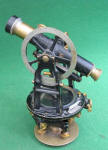 Bausch
& Lomb Explorer / Expedition Size Transit w/ Box This
compact / small size transit is very nice and very unusual. Bausch and Lomb
first opened their doors in the mid 1850's and were well known in the optics business
before they went into a business partnership with, George Saegmueller in 1905, and then Carl Zeiss in 1907
at which point they also began to produce Surveying instruments, transits and other
scientific and engineering instruments.
They manufactured surveying instruments up until the entry of the United States into the First World War
in about 1917. After the war, production of these sorts lines was never resumed.
It seems there was better money making things for the military and that became their primary focus.
Bausch
& Lomb Explorer / Expedition Size Transit w/ Box This
compact / small size transit is very nice and very unusual. Bausch and Lomb
first opened their doors in the mid 1850's and were well known in the optics business
before they went into a business partnership with, George Saegmueller in 1905, and then Carl Zeiss in 1907
at which point they also began to produce Surveying instruments, transits and other
scientific and engineering instruments.
They manufactured surveying instruments up until the entry of the United States into the First World War
in about 1917. After the war, production of these sorts lines was never resumed.
It seems there was better money making things for the military and that became their primary focus. Everything on this small transit seems to be working nicely. The scope is approx. 8" long and the optics are clear with crosshairs present. The serial # 7937 is seen under the compass glass. There are also 2 patent dates found there from 1903, as well as the name Bausch & Lomb Optical Co. Note how the leveling vials are incorporated into the plate under the compass glass as opposed to being mounted on the standards like on most larger instruments. The transit fits into the box laying on it side. The box is OK with normal scuffs. The different finishes on the mostly brass instrument are original and OK. They purposefully left some areas like the base and eyepieces in natural brass. It has a 3" full vertical circle scaled to 30'.
Given the short production span of 10 years or so, and the limited number produced, instruments by these folks are pretty hard to come by.
Good . . . . . .$950.00 SOLD!!
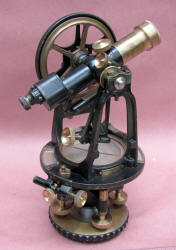 Heitzler
Instrument Co. Transit Serial #52 Marked #1 Solar w/ 1911 Patent This is a very unusual transit in several respects. The maker mark,
Heitzler Instrument Co. Denver Colo. and the info about this transit
being serial # 52 and #1 Solar can be found under the glass on the
compass face. Frank Heitzler operated his mathematical and instrument
making business from Denver Colorado back near the turn of the last
century. He is first listed in 1904 as working by himself. For a
short period of time starting in 1906 he was in a partnership with a
fellow named Weiss an optician and instrument maker. He opened his own
business, Heitzler Instrument Co. for a short 2 years in 1910 -1912
before he disappeared from the directories. There are short Bio's on
both Weiss and Heitzler in Smarts book on surveying instruments, and all
of that was derived from that.
Heitzler
Instrument Co. Transit Serial #52 Marked #1 Solar w/ 1911 Patent This is a very unusual transit in several respects. The maker mark,
Heitzler Instrument Co. Denver Colo. and the info about this transit
being serial # 52 and #1 Solar can be found under the glass on the
compass face. Frank Heitzler operated his mathematical and instrument
making business from Denver Colorado back near the turn of the last
century. He is first listed in 1904 as working by himself. For a
short period of time starting in 1906 he was in a partnership with a
fellow named Weiss an optician and instrument maker. He opened his own
business, Heitzler Instrument Co. for a short 2 years in 1910 -1912
before he disappeared from the directories. There are short Bio's on
both Weiss and Heitzler in Smarts book on surveying instruments, and all
of that was derived from that.The Smithsonian has a transit / instrument that looks very similar to this one marked Weiss & Heitzler in their online collection.They show, and refer to the binocular style scope like this transit has, but get the patent date / number wrong. The correct patent for the offset scope with prisms, much like a binocular is Pat. 891773 - June 23 1908. Heitzler pulled another patent, US Pat. 946602 - Jan 18, 1910, for a transit with a very unusual feature of a sliding standard so that the transit could be used for mining purposes when the standards were shifted to the edge of the plate. There are no known examples of that transit known.
This transit has a 3rd patent date under the glass of April 1911 and just above that says Solar #1. I can find no reference to this patent or any patent for anything solar related for this transit. Inside the box there is a space in the bottom of the box for what one would assume would hold a striding level. It might have been meant to hold something bigger, but there is no solar attachment or striding level there or elsewhere. There is also no attachment point on the transit to accept a solar attachment. Perhaps it just sat on top like a striding level might, but there are no points that show any wear from something like this either. A mystery!!
Parts of this transit like the screw base are made of Aluminum. Most of the rest is brass. The scope is 8" long. The compass needle 3 1/2" and working. The finish is in super condition, and appears to be a two coat process with a dark green / black, over a lighter base coat with some of that showing through for the effect it gives.. That is factory. The optics are clear and not inverted. The crosshairs are present as well. The vertical circle is 4" Dia. All motions are free, and operable.
This is an interesting and rare transit. With a bit more research, and some luck, you could be the owner of one of the rarest forms of all surveying instruments produced. Think about that, a solar transit with the serial # 52 and the #1, solar that maker made. This transit would be a fine addition to any collection of surveying instruments. Opportunity Knocks.
Good + . . . . . .$1750.00 SOLD!
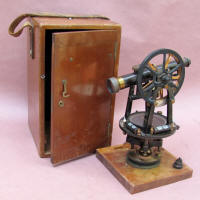 William
Ainsworth & Sons of Denver Colorado Mining Transit
This is a very small and light transit whose overall condition is very
nice. The original bronzed lacquer finish is in super condition. The
exposed brass has developed a nice even patina. It has a 3 1/2" needle
and is either an expedition or explore model given the small size. The
transit has threaded axle ends to allow for a secondary auxiliary scope
or solar attachment and counterweight. Neither is present. The idea for
a second scope is to allow the user to shoot angles that would otherwise
be impossible because of the plate being in the way such as at very
steep angles, or straight down.
William
Ainsworth & Sons of Denver Colorado Mining Transit
This is a very small and light transit whose overall condition is very
nice. The original bronzed lacquer finish is in super condition. The
exposed brass has developed a nice even patina. It has a 3 1/2" needle
and is either an expedition or explore model given the small size. The
transit has threaded axle ends to allow for a secondary auxiliary scope
or solar attachment and counterweight. Neither is present. The idea for
a second scope is to allow the user to shoot angles that would otherwise
be impossible because of the plate being in the way such as at very
steep angles, or straight down.The main scope is just over 8" long. The serial # is 2658. William Ainsworth was an English immigrant who first opened his door for the making of surveying instruments in Denver in the 1880's. In 1905 he added Sons to the name, so we can assume this transit dates from near that date. Ainsworth is most famous for their production of the Brunton pocket compass which is still produced today. In the day they were a well known and respected regional maker of surveying instruments, scales, and watches.
The tripod mount is only 2 1/4" I have a Ainsworth tripod that is almost miniature with a 2 7/8 ring that is smaller than a Gurley explorer or expedition size tripod. Imagine how small and light the tripod for this would be with a 2 1/4" ring. All level vials are all good and all motions are free. The optics are good, and the crosshairs are visible. They are the finest that I have ever seen. All in all a pretty rare instrument that will not turn up often and will make for a great display in the mining collection, or the surveying instrument collection.
Good+ . . . . . . .$850.00 SOLD!
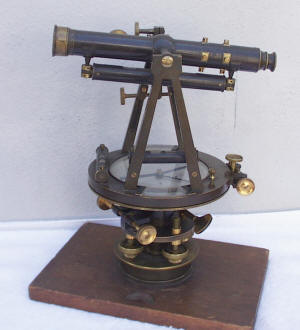 William
Stackpole Surveyors / Engineers Transit This surveyor's transit
is in good condition. Stackpole & Brother was a relatively early New York surveying
instrument maker and began operations in the mid 1800's. The box as
shown in the pics is pretty nice as well. The bubbles are all good.
The compass is nice and the needle swings freely. The company name and location
are on the compass face under the glass and pictured below. The optics are
clear, and the crosshairs (3h & 1v) are good. Stackpole produced a quality
product and this transit is no exception. Note the positioning of the tangent lock.
The green lacquer finish is 90% or better and looks great Those areas
that were not lacquered have a nice even patina.
William
Stackpole Surveyors / Engineers Transit This surveyor's transit
is in good condition. Stackpole & Brother was a relatively early New York surveying
instrument maker and began operations in the mid 1800's. The box as
shown in the pics is pretty nice as well. The bubbles are all good.
The compass is nice and the needle swings freely. The company name and location
are on the compass face under the glass and pictured below. The optics are
clear, and the crosshairs (3h & 1v) are good. Stackpole produced a quality
product and this transit is no exception. Note the positioning of the tangent lock.
The green lacquer finish is 90% or better and looks great Those areas
that were not lacquered have a nice even patina.The Smithsonian site has a bio on the brothers who formed the company, and they have several of their instruments in their collection.
See below for some of the info from the Smithsonian site.
Good+ . . . . . . .$850.00 SOLD!
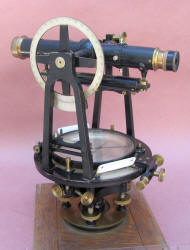 Queen
& Co Engineers Transit
This is a large & nice looking Queen & Co. Engineers transit. James
Queen first opened shop in 1853, but the name of the firm was changed to
Queen and Co in 1896 and this dates from after that time.The serial # 8414.is found on the compass face under the glass. There
are no published records to help pinpoint the exact date that this was made
but it dates from before 1912 when the name was again changed..
Queen
& Co Engineers Transit
This is a large & nice looking Queen & Co. Engineers transit. James
Queen first opened shop in 1853, but the name of the firm was changed to
Queen and Co in 1896 and this dates from after that time.The serial # 8414.is found on the compass face under the glass. There
are no published records to help pinpoint the exact date that this was made
but it dates from before 1912 when the name was again changed.. The transit is in overall very nice condition and has 90% or more of the black matt finish remaining. The scope measures 11" long. It has a 5" needle, and the silvered compass face is nice. The needle swings freely and operates as it should. . The horizontal vernier are graduated to 30 degrees. The small opaque shades are present.All screws and motions move freely and as they should. The optics are clear and crosshairs present. It takes a 3 1/2" x 8 tripod fixed leg tripod which is present but not pictured. It is included in the price. . The box is OK, but is damaged and has been repaired. A nice display piece at a reasonable price.
Good . . . . . .$550.00 SOLD!!
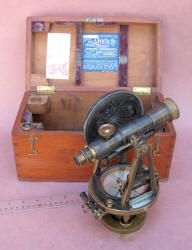 Fauth & Co. Expedition Size Transit
This Fauth & Co. of Washington DC expedition size transit is a rare and unusual
surveying instrument.This company was formed in the 1870's between George Saegmuller and
his two brothers in law, Camille Fauth and Henry Lockwood. The transit is marked with the Fauth
& Co. as well as the Washington DC location under the glass on the
compass face. The serial #50 is also found under the glass. If I am reading right at the Smithsonian site
George Saegmuller was a partner in the firm at this time and applied serial
#'s to the instruments only after 1887. The company disbanded in 1905
and I assume this dates from near 1887 with so low a #.
Fauth & Co. Expedition Size Transit
This Fauth & Co. of Washington DC expedition size transit is a rare and unusual
surveying instrument.This company was formed in the 1870's between George Saegmuller and
his two brothers in law, Camille Fauth and Henry Lockwood. The transit is marked with the Fauth
& Co. as well as the Washington DC location under the glass on the
compass face. The serial #50 is also found under the glass. If I am reading right at the Smithsonian site
George Saegmuller was a partner in the firm at this time and applied serial
#'s to the instruments only after 1887. The company disbanded in 1905
and I assume this dates from near 1887 with so low a #. The transit has an 7" scope and would be designated as a Expedition model. Be sure to see the leather case that the wooden box slips into. Being an expedition size the makers tried to keep everything as small and compact as possible to be lighter and easier to transport in the field. The box for the transit is a study in compactness. The leather field case has done a fine job protecting the mahogany box. The mahogany box for the transit shows just a few minor scuffs from storage. The leather covering is in fine condition as well with minor losses to the stitching and the straps missing.
All motions are free and turn as they should. The optics are perfect and exhibit no cloudiness or other problems. The image is inverted, and I do not see any crosshairs. The 3" compass needle swings freely and goes to north. There are 3 different eyepieces, one of them being a right angle. The tripod size looks to be 2.75 x 13.
This small interesting instrument represents an opportunity that will not likely present itself again for a long time. Highly recommended!!
Fine . . . . . .$1050.00 SOLD!!
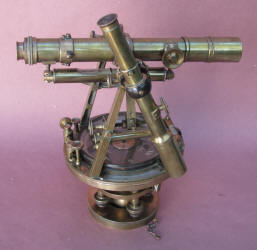 Heller & Brightly Mining Transit w/ Auxiliary Scope
& Tripod The main scope on this
large surveyor's or engineers transit is 11" long. The serial # is
4928 which from published records we can assume dates this mining transit from
right around 1876 just a few years after Heller and Brightly formed their
partnership in 1870. Heller had worked for Young, and before Young died
in 1870 he had become a partner in that firm. This was before teaming up with Brightly
soon after Young's death and starting the new firm of Heller & Brightly.
Heller & Brightly Mining Transit w/ Auxiliary Scope
& Tripod The main scope on this
large surveyor's or engineers transit is 11" long. The serial # is
4928 which from published records we can assume dates this mining transit from
right around 1876 just a few years after Heller and Brightly formed their
partnership in 1870. Heller had worked for Young, and before Young died
in 1870 he had become a partner in that firm. This was before teaming up with Brightly
soon after Young's death and starting the new firm of Heller & Brightly. The transit is fitted for, and has the secondary auxiliary scope making this what would be termed a mining transit. Heller & Brightly instruments in this form are very rare. The box is fitted for the scope and other auxiliary pieces as well. This transit is set to accept the secondary scope on just the right side and not on top. It has a very unusual split nut fitting that uses friction to hold the scope onto the spindle provided. The axle on the other side of the instrument is set up to take a counterweight, and there is a place for a counterweight in the box, but it is missing. The idea for a second scope is to allow the user to shoot angles that would otherwise be impossible because of the plate being in the way such as at very steep angles, or straight down.
The overall condition of this rare mining transit is very nice. The natural brass finish has developed a nice even patina. This transit has been on display in an office for the last 25 years or so. It was found in Oregon, and the story was that it had come from PA where it had originally been in use. Also of note is that the serial numbers on the instrument, box, and tripod all match. The tripod is OK noting that it appears one leg has an early glue repair on a split in one rail. The original screwdriver is in the box, and both scopes have sunshades. All level vials are all good. All in all a pretty rare instrument that will not turn up often and will make for a great display in the mining collection, or the surveying instrument collection.
Good+ . . . . . . .$3250.00 SOLD!!
Info on Heller & Brightly from the Smithsonian Site
Heller & Brightly Charles S. Heller (1839–1912) was born in Germany, and moved with his family to the United States in the late 1840s. He went to work for William J. Young in 1855, and became a partner in William J. Young & Co. in 1865. Charles H. Brightly (1817–1897) was born in England, arrived in the United States in the 1830s, and worked as a machinist in Philadelphia before going into partnership with Heller in 1870. Within a few years Heller & Brightly were said to have "done more than any other [firm] in this country of late years to increase competition in the trade, and to wake up the different makers to a sense of the many improvements that may be made in the instruments in common use." Heller & Brightly instruments were used in every state in the union, and in several foreign countries. The firm was incorporated in 1926, and remained in business until 1968.Heller & Brightly was a traditional craft workshop. There were only a few employees at any one time, each could produce an entire instrument, and each was reasonably well paid. They produced some 100 instruments per year from 1870 to 1887. Annual production rose to 216 instruments in 1891, then dropped precipitously and remained at modest levels thereafter. Each instrument has a serial number, the first being #4400. Most Heller & Brightly instruments were ordered directly from the shop, with only a few sold in stores.
Ref: Robert C. Miller, "The Heller & Brightly Records," Rittenhouse 4 (1990): 43–55.
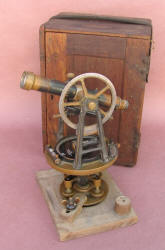 A. Lietz of San Francisco Preliminary / Light Mountain Size "Universal Jr." Transit
This A Lietz transit has a serial # of 6022. It looks to date from 1920 or
earlier. There are no certain means to know the exact date for Lietz
instruments other than they stopped producing them and started importing
them right after WWII. A. Lietz first opened his business in San
Francisco in 1882.
A. Lietz of San Francisco Preliminary / Light Mountain Size "Universal Jr." Transit
This A Lietz transit has a serial # of 6022. It looks to date from 1920 or
earlier. There are no certain means to know the exact date for Lietz
instruments other than they stopped producing them and started importing
them right after WWII. A. Lietz first opened his business in San
Francisco in 1882. This is a small compact transit with a 9" scope and 3 1/2" needle. It is designated the Universal Jr. on the compass face. There is a drilled and tapped hole in the top of the scope as if to accept a solar attachment or mining scope. The compass face is very nice and there is no corrosion or damage. The finish is a worn dark lacquer and natural brass. It has a great patina with contrasts of the different natural brass colors used for the different parts. The transit is in overall very nice condition. All screws and motions move freely and operate as they should. The optics are clear and clean and there is one vertical and three horizontal crosshairs. The box is original and has been oiled. The door has an early repair done to the inside. This transit also includes the original proper tripod. It has repairs done to two of the legs that were carefully and tastefully done. You can almost not see them. Although it has not been calibrated this will make for a nice user or will display nicely in the proper setting.
Good + . . . . . .$750.00 SOLD!
Dietzgen Light Mountain Size Engineering Transit This small Transit is in good condition. The scope is 9" long and the vertical circle is 5" Dia. Dietzgen in all of their catalogs I have refer to all of their transits as being Engineering transits and offered them in 3 or 4 different sizes. This looks to be a #6024, and the serial # is 22930 dating it from 1936 or so.
This is a nice compact instrument that from the finish on the box was once part of the military or forest service. The finish is nice except for the one are on the tube where someone removed the property of sticker that was once there. The optics are crisp, and the cross hairs are a matrix like setup with several intersections of vertical, horizontal, and diagonal lines. It will display nicely, or after a calibration make a good user.
Good . . . . .$450.00 SOLD
Bostrom #4 Transit / Level This small combination Transit / Level is in good condition. It is a precision but simple instrument that was offered for general layouts and lines by large concerns like Sears, Montgomery Wards or other outfits that sold surveying instruments for general use. This style of surveying instrument are sometimes referred to as Farm levels This one is unmarked as to maker but is a Bostrom. I would estimate it dates from the 40's or so. As can be seen half of the box is present. There is no tripod. It will make for a good general user, or a nice display piece on the shelf.
Good . . . . .$95.00 SOLD
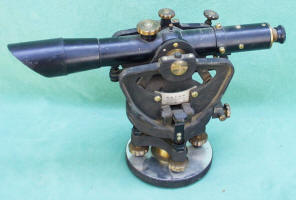 Fennel / Kassel Builders Transit / Level This is a quality transit / level made by the well
known German firm Fennel / Kassel. The box is marked West Germany which would date this as post WWII.
It looks a lot like the David White Builders transit I use to use for general layout, corners, and grades.
This instrument is set up much the same with a positive lock for the level / grade function, and
just one level vial below the scope to set up. Everything about the transit is nice, and
I believe it is ready to go back to work. The box needs a new clap / latch, but is otherwise OK.
It takes a standard 3 1/2 x 8 tripod.
Fennel / Kassel Builders Transit / Level This is a quality transit / level made by the well
known German firm Fennel / Kassel. The box is marked West Germany which would date this as post WWII.
It looks a lot like the David White Builders transit I use to use for general layout, corners, and grades.
This instrument is set up much the same with a positive lock for the level / grade function, and
just one level vial below the scope to set up. Everything about the transit is nice, and
I believe it is ready to go back to work. The box needs a new clap / latch, but is otherwise OK.
It takes a standard 3 1/2 x 8 tripod.
Good . . . . .$150.00 SOLD
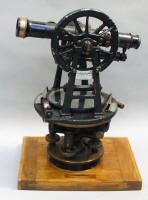 A.
Lietz / San Francisco CA Light Mountain Size Transit This small Transit
is in good condition. It dates from the 30's or so. The box is
nice, and the tripod is included.
A.
Lietz / San Francisco CA Light Mountain Size Transit This small Transit
is in good condition. It dates from the 30's or so. The box is
nice, and the tripod is included.
Good . . . . .$450.00 SOLD
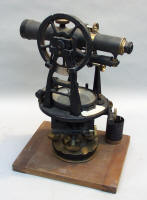 Heller & Brightly
Mining Transit
This is a later piece by this famous PA maker. Note that the ends
of the main axle of the scopes are threaded and set up to receive a
second auxiliary scope for use in mines and the like.
Heller & Brightly
Mining Transit
This is a later piece by this famous PA maker. Note that the ends
of the main axle of the scopes are threaded and set up to receive a
second auxiliary scope for use in mines and the like.
Good + . . . . . .$750.00 SOLD!!
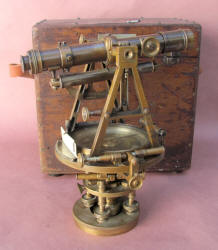 Heller & Brightly Engineer's Transit
This original condition of this large and graphic looking instrument is very
nice. The serial #
8150 is on the compass face of
this Heller & Brightly Engineer's or Surveyor's transit.
That would
date it from approx 1915. That information is available on the very
informative site
www.surveyhistory.org where you can find dating charts for not only
Heller & Brightly instruments but other surveying instrument makers as well. The
Smithsonian site has a detailed bio on this company and informs us that his company was formed between Charles Heller
and Charles Brightly in the 1870's.
Heller & Brightly Engineer's Transit
This original condition of this large and graphic looking instrument is very
nice. The serial #
8150 is on the compass face of
this Heller & Brightly Engineer's or Surveyor's transit.
That would
date it from approx 1915. That information is available on the very
informative site
www.surveyhistory.org where you can find dating charts for not only
Heller & Brightly instruments but other surveying instrument makers as well. The
Smithsonian site has a detailed bio on this company and informs us that his company was formed between Charles Heller
and Charles Brightly in the 1870's. The Mahogany box is nice. The leveling head is detachable and stores separately inside the box. All motions on it and the instrument are free and smooth. The compass needle does not swing as it should and the lock feature does not move the compass rose up and down to release it. The level vials are all good. The optics and crosshairs are good. This transit also includes a correctly marked and original tripod. The tripod is very nice with nicely tapered and curved legs. Note the heavy duty locks on the legs. Heller and Brightly instruments were very well made and had a lot of ungraded features that made their instruments stand apart from other lesser makers from the same era.
These early transits were hand built by Heller and Brightly employees. Over the course of their instrument making period they produced approx 4000 instruments. Most were sold by order rather than marketed by distributers.All in all one of the nicest made American transits that I have had the pleasure of offering.
Good + . . . . . .$1250.00 SOLD!!
Heller & Brightly Info from the Smithsonian Site
Heller & Brightly Charles S. Heller (1839–1912) was born in Germany, and moved with his family to the United States in the late 1840s. He went to work for William J. Young in 1855, and became a partner in William J. Young & Co. in 1865. Charles H. Brightly (1817–1897) was born in England, arrived in the United States in the 1830s, and worked as a machinist in Philadelphia before going into partnership with Heller in 1870. Within a few years Heller & Brightly were said to have "done more than any other [firm] in this country of late years to increase competition in the trade, and to wake up the different makers to a sense of the many improvements that may be made in the instruments in common use." Heller & Brightly instruments were used in every state in the union, and in several foreign countries. The firm was incorporated in 1926, and remained in business until 1968.
Heller & Brightly was a traditional craft workshop. There were only a few employees at any one time, each could produce an entire instrument, and each was reasonably well paid. They produced some 100 instruments per year from 1870 to 1887. Annual production rose to 216 instruments in 1891, then dropped precipitously and remained at modest levels thereafter. Each instrument has a serial number, the first being #4400. Most Heller & Brightly instruments were ordered directly from the shop, with only a few sold in stores.
Ref: Robert C. Miller, "The Heller & Brightly Records," Rittenhouse 4 (1990): 43–55. Link: http://americanhistory2.si.edu/surveying/maker.cfm?makerid=16
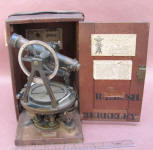 A.
Lietz & Co. Solar Transit
This A. Lietz solar transit has a serial # 74 and was probably made
during Adolph Lietz's first year or two being in operation in San Francisco
California. Smart
states in his book on surveying instrument makers that he first opened for
business in 1882.
A.
Lietz & Co. Solar Transit
This A. Lietz solar transit has a serial # 74 and was probably made
during Adolph Lietz's first year or two being in operation in San Francisco
California. Smart
states in his book on surveying instrument makers that he first opened for
business in 1882. This unusual transit is in overall nice condition. It is a small compact size transit set up to receive a solar attachment on the top of the scope. That attachment is not present. I believe that Lietz utilized the Saegmuller style attachment similar to those found on K & E / Keuffel & Esser instruments but this is set up with a threaded mount, and not a dovetail as typically seen on the K & E version..
The main scope is 7" long and so this could be referred to as either a light mountain or explorer / expedition size transit. It has developed a nice patina over the last 100 plus years. The compass face is marked with the maker name, location and #74 serial number. All motions are free and the optics are good. It has a full vertical silver vernier circle. The mahogany box is OK. This instrument would sell for 3 to 4 times the listed price if one could find the solar attachment that fits on it.
Good + . . . . . . .$750.00 SOLD!!
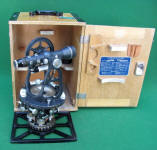 Eagle
Brand Transit This transit was sold as surplus from
a college
that either discontinued their engineering program or upgraded to more
modern instruments. It dates from the early 60's. There is a pic
of the information tag on the door that gives all the specs. It is a
well made precision instrument. The overall condition is nice and it appears
to have led an easy life spending most of its time on the shelf and not in
the field. The optics are clear, and the crosshairs present. The
compass is operational. All
other motions are free and I see no issues. It takes a 3 1/2 x 8 tripod, and
I have several designed for this instrument listed for sale on another page
at this site. It
will make a great user for the general contractor or casual user.
Eagle
Brand Transit This transit was sold as surplus from
a college
that either discontinued their engineering program or upgraded to more
modern instruments. It dates from the early 60's. There is a pic
of the information tag on the door that gives all the specs. It is a
well made precision instrument. The overall condition is nice and it appears
to have led an easy life spending most of its time on the shelf and not in
the field. The optics are clear, and the crosshairs present. The
compass is operational. All
other motions are free and I see no issues. It takes a 3 1/2 x 8 tripod, and
I have several designed for this instrument listed for sale on another page
at this site. It
will make a great user for the general contractor or casual user.
Good + . . . . .$250.00 SOLD!!
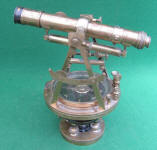 Heller
& Brightly Engineer's Transit In the early 1870's Charles Heller and Charles Brightly
formed this well known Pennsylvania surveying and scientific instrument making company.
They made very large and very heavy duty pieces. This transit has an
11" long scope, and the bright laquear finish is original and correct.
Heller
& Brightly Engineer's Transit In the early 1870's Charles Heller and Charles Brightly
formed this well known Pennsylvania surveying and scientific instrument making company.
They made very large and very heavy duty pieces. This transit has an
11" long scope, and the bright laquear finish is original and correct. The Mahogany box is nice, noting that the leather handle has broken off. Note how the leveling base is housed separately in the box, and how it is a twist lock affair to join the top half to it. All motions are free and smooth and the level vials are all good. There is one empty hole on the barrel that would hold a crosshair and so while the optics are OK, there is a missing crosshair.
Heller and Brightly was a small company that produced less than 100 instruments a year in their early days. All in all a nice example that has a great patina and graphic look to it. It will display very nicely.
Good . . . . . .$750.00 SOLD!!
Info from the Smithsonian Site / Heller & Brightly
Charles S. Heller (1839–1912) was born in Germany, and moved with his family to the United States in the late 1840s. He went to work for William J. Young in 1855, and became a partner in William J. Young & Co. in 1865. Charles H. Brightly (1817–1897) was born in England, arrived in the United States in the 1830s, and worked as a machinist in Philadelphia before going into partnership with Heller in 1870. Within a few years Heller & Brightly were said to have "done more than any other [firm] in this country of late years to increase competition in the trade, and to wake up the different makers to a sense of the many improvements that may be made in the instruments in common use." Heller & Brightly instruments were used in every state in the union, and in several foreign countries. The firm was incorporated in 1926, and remained in business until 1968.Heller & Brightly was a traditional craft workshop. There were only a few employees at any one time, each could produce an entire instrument, and each was reasonably well paid. They produced some 100 instruments per year from 1870 to 1887. Annual production rose to 216 instruments in 1891, then dropped precipitously and remained at modest levels thereafter. Each instrument has a serial number, the first being #4400. Most Heller & Brightly instruments were ordered directly from the shop, with only a few sold in stores.
Ref: Robert C. Miller, "The Heller & Brightly Records," Rittenhouse 4 (1990): 43–55.
Link: http://americanhistory2.si.edu/surveying/maker.cfm?makerid=16
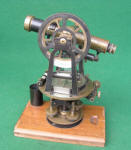 Mahn
& Co. St. Louis Mo. #3 Light Mountain Transit This small surveying
transit
is by a little known regional Midwest maker from St Louis MO. Herman Mahn's working dates
were from 1891 -1906.
It is in excellent overall condition.
Mahn
& Co. St. Louis Mo. #3 Light Mountain Transit This small surveying
transit
is by a little known regional Midwest maker from St Louis MO. Herman Mahn's working dates
were from 1891 -1906.
It is in excellent overall condition.I found an online catalog for this company and I believe they refer to this as their #3 Light Mountain transit. The mahogany box spent most of its life inside the outer leather case seen in pic 6009 and the finishes on it are near perfect. The leather case does have a tear in it. The scope is 8.5" long the image erect and crosshairs are present. The optics are crisp and clear. All of the level vials are full and appear to be original. It has a 4" vertical circle.
This transit came with a marked collapsible leg Gurley tripod that looks to be their explorer / expdition size with a XXX size mount. The legs are their early square-ish design with double lock screws and brass fittings. It is in fine condition and the transit fits it properly. I will sell it separately for $225.00 if you need it for something else.
A small good looking compact instrument that will be a welcome addition to any display or collection.
Fine . . . . . . SOLD!!
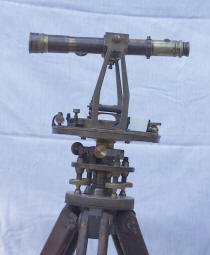 William Young Transit
This is a nice early engineer's transit by the famous PA maker William
Young. It comes with the proper tripod.
William Young Transit
This is a nice early engineer's transit by the famous PA maker William
Young. It comes with the proper tripod.
Good + . . . . . .$650.00 SOLD!
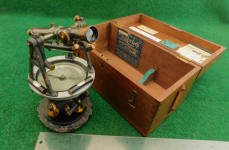 Lietz
Type 22 Preliminary Transit in Box
An interesting instrument. The tag indicates it dates from the 1920s. With a 6" scope, and weighing just 2 1/2 pounds ones first thought
would be to call this near miniature transit an expedition size transit, but
Lietz calls it their
Type 22 Preliminary Transit and their description of it mentions it not being for
precise work, but rather for farmers, ranchers, ditchers and so forth.
Lietz
Type 22 Preliminary Transit in Box
An interesting instrument. The tag indicates it dates from the 1920s. With a 6" scope, and weighing just 2 1/2 pounds ones first thought
would be to call this near miniature transit an expedition size transit, but
Lietz calls it their
Type 22 Preliminary Transit and their description of it mentions it not being for
precise work, but rather for farmers, ranchers, ditchers and so forth.This example has had the base modified so it will fit on a standard tripod. They took the hard plastic cap off a transit and drilled a hole and bolted the transit to that. Should work, but - - - - . It could be easily removed and would be back to the way it was first offered. Beyond that it is a nice looking instrument that will display nicely where a small instrument is desirable.
Good . . . . . . $175.00 SOLD!!
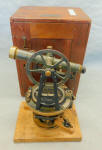 Lietz
"Universal Junior" Solar Transit Nice
overall condition. This small recon or preliminary size transit is drilled to accept a solar
attachment on the top of the scope. The transit is in very nice
overall condition. All motions are free, good optics, good bubbles,
crosshairs, etc. Box is nice. An unusual instrument by the famous San Francisco
maker.
Lietz
"Universal Junior" Solar Transit Nice
overall condition. This small recon or preliminary size transit is drilled to accept a solar
attachment on the top of the scope. The transit is in very nice
overall condition. All motions are free, good optics, good bubbles,
crosshairs, etc. Box is nice. An unusual instrument by the famous San Francisco
maker. Good + . . . . . . $495.00 SOLD!!
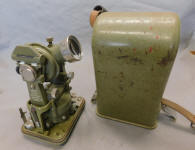 Kern
Aarau DKM2 Theodolite / Transit Top of the line Swiss optical surveying instrument in its day. Looks good. Crisp optics.
Good crosshairs, bubbles, mirrors, etc. Everything seems to be functioning correctly and right.
Kern
Aarau DKM2 Theodolite / Transit Top of the line Swiss optical surveying instrument in its day. Looks good. Crisp optics.
Good crosshairs, bubbles, mirrors, etc. Everything seems to be functioning correctly and right. Good + . . . . . $495.00 SOLD!!
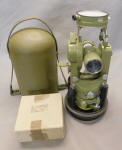 Wild Heerbrugg T 16 Theodolite
w/ Top Mount Auxiliary Compass This top of the line Swiss made
theodolite was made for the US Military. It looks to have spent most of its life sitting on a shelf in some warehouse before being sold as surplus or
otherwise disposed of. The serial # is 119904. There are more numbers that probably date it and mean something to someone.
(see pics) I am guessing it dates from the 1970s.
Wild Heerbrugg T 16 Theodolite
w/ Top Mount Auxiliary Compass This top of the line Swiss made
theodolite was made for the US Military. It looks to have spent most of its life sitting on a shelf in some warehouse before being sold as surplus or
otherwise disposed of. The serial # is 119904. There are more numbers that probably date it and mean something to someone.
(see pics) I am guessing it dates from the 1970s.
The horizontal limb graduation or scale is not the typical 360 degrees one would expect, but rather 640 / to the full circle. I have been told this is Milliradians. Further explanations or comments on this from me are above my pay grade.
The Green finish is near perfect. The optics are crisp and clear. All sorts of crosshairs are visible. Everything seems to be working and in order. It has not been tested or used. The outer bullet case has a couple superficial dents, but is otherwise very nice and speaks to the light use, if any at all, this saw in the field.
The auxiliary compass is also listed separately in the ad below. It is shown in the first few pics of this ad. It fits, and is included in the price.
An interesting instrument that will display very nicely. Nice!!
Fine . . . . . . $695.00 SOLD!!
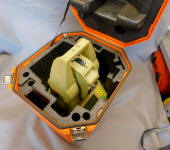 Leica TCA 1800 - Total Station w/ Case
Looks good. Untested. Pics tell most of the story. Please look at all the pics to see the details and condition. What you see
is what you get. Bid it to own it!!
This instrument is somewhat newer than what we typically deal in, and I know
little about this era instrument.
Leica TCA 1800 - Total Station w/ Case
Looks good. Untested. Pics tell most of the story. Please look at all the pics to see the details and condition. What you see
is what you get. Bid it to own it!!
This instrument is somewhat newer than what we typically deal in, and I know
little about this era instrument.This c. 1990s vintage surveying instrument and related contemporary survey instruments I am currently selling came from a local northern CA. Engineering outfit started in the 1940s. They are still listed in the area, and have moved up, or moved on.
Good . . . . . . $1850.00 SOLD!!
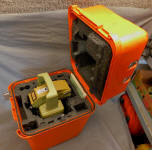 WILD T1000
"THEOMAT" - Theodolite w/ Case Untested.
Includes two instruction booklets. Top of hard case is cracked. The
instrument looks OK.
WILD T1000
"THEOMAT" - Theodolite w/ Case Untested.
Includes two instruction booklets. Top of hard case is cracked. The
instrument looks OK.This c. 1980s - 1990s vintage Swiss made surveying instrument and related contemporary survey instruments I am currently selling came from a local northern CA. Engineering outfit started in the 1940s. They are still listed in the area, and have moved up, or moved on.
Good - . . . . . . $140.00 SOLD!!
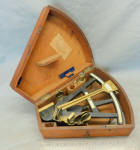 D.
Filby Hamburg Germany Ebony & Ivory Octant / Sextant
D. Filby was a well known and respected German maker who sold his
business to Plath in 1862. The D. Filby company operated from 1837 till it
was sold to the Carl Plath company in 1862. It was made in Hamburg, Germany.
The overall condition of this unusual Pre Civil War Antique Maritime Navigational device
is very nice.
D.
Filby Hamburg Germany Ebony & Ivory Octant / Sextant
D. Filby was a well known and respected German maker who sold his
business to Plath in 1862. The D. Filby company operated from 1837 till it
was sold to the Carl Plath company in 1862. It was made in Hamburg, Germany.
The overall condition of this unusual Pre Civil War Antique Maritime Navigational device
is very nice.The body of this mariner's navigational octant is made of ebony w/ brass or bronze fittings. The D. Filby name and Hamburg are inscribed on the ivory plate set in the cross bar. The ebony frame is very nice. The index bar and shade mirrors (5 total, 2 circular, 3 square) all move freely. The shade mirrors have colored lenses. The horizon and index mirrors are intact. The ivory name plate and scales are good. The wood box is original with some damage. A small piece of the box bottom is missing. There is a label from the seller or distributer inside.
This instrument is properly called an octant although many refer to them as sextants. It is a graphic, unusual, and nice looking Maritime Navigational Instrument that will make for a great addition to any number of collections.
Good + . . . . . . $695.000 SOLD!!
Craftsman Transit / Level This small combination Transit / Level is in good condition. It is a simple style of instrument that was offered for general layouts and lines by large concerns like Sears, Montgomery Wards or other outfits that sold surveying instruments for general use. It has a sticker identifying it as being sold by Sears. I would estimate it dates from the 40's or so. It will make for a good general user, or a nice display piece on the shelf.
Good . . . . .$95.00 SOLD
This is just a sample of the many
antique & collectible surveying instruments we have sold.
Click link to see other
Sales Archive Pages on this Site.
We Buy Quality Surveying Related Antiques
Contact Us at
AntiqBuyer@gmail.com
Our current offering of Antiques for sale are at our sister Website Patented-Antiques.com.
This website is Copyrighted
Larry & Carole Meeker